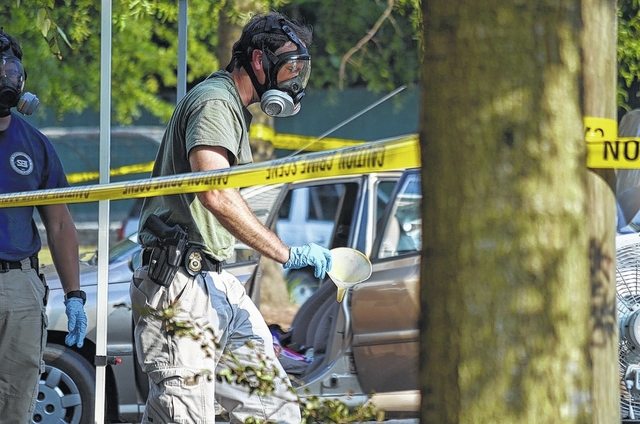Following the Oct. 30 discovery of a meth lab in a city couple’s home, Wadesboro Police Chief Thedis Spencer issued a warning about meth labs’ inherent dangers.
Meth labs are dangerous for those cooking the caustic cocktail and those cleaning it up, but they are also very costly, Spencer said.
“When a meth lab is discovered, emergency cleanup teams are called in to properly dispose of the hazardous chemicals being used and produced,” Spencer said via email. “These cleanups can potentially have costs of $10,000 or more depending upon the level of contamination at a site.”
The financial burden of clearing the labs falls on the public, as the money is taken from taxes, Spencer said. His police department has to call in a hazardous waste response team from the State Bureau of Investigation to help dispose of the mess.
Anson County has had the fifth-highest amount of meth lab busts out of all 100 counties in North Carolina this year as of July 31, according to data from the SBI. By the end of July, there had already been 12 meth lab busts in the county.
This year, Anson ranks only behind Gaston, Johnston, Richmond and Harnett counties, which respectively had 25, 24, 20 and 13 meth lab busts in the first seven months of 2015.
In 2013, Anson ranked third in the state with 30 meth lab busts. In 2012, Anson was fourth-highest in the state, with 21 labs discovered.
The SBI first started posting meth lab data online in 2001. Most counties had three or fewer meth labs in 2001, with a total of only 34 found in the state that year.
By contrast, halfway through this year on July 31, there were more than 300 discovered in the state.
Officials attribute the sharp spike to an increase of one-pot or “shake-and-bake” labs, with smaller quantities of the drug being mixed in plastic soda bottles.
A full 86 percent of the 557 meth labs state agents busted in 2014 were one-pot cooks. Assistant Special Agent-in-Charge Kelly Page said the bottles of chalky sludge are no less dangerous than full-size meth labs found in homes, sheds and motel rooms.
“There is no difference,” Page told the Richmond County Daily Journal. “Even if it’s just a one-pot, it’s just as dangerous.”
Spencer said that the smell of an active meth lab can give it away. He said that labs may smell like:
- Paint thinner or varnish
- Ether or hospital
- Sour or vinegar
- Ammonia (such as the scent of window cleaner, fertilizers or cat urine)
On its website, the SBI lists several other clues that could suggest meth manufacturing is taking place.
“Homemade ‘kitchen’ meth labs can look so ordinary that they may escape detection by the untrained eye,” the SBI states on the website. “Discarded containers that have been used to make meth using the one-pot method are dangerously contaminated but may look harmless.”
Signs of a meth lab may include a large amount of cold medicine, several purchases of products with pseudoephedrine (found in cold medicines) from several pharmacies and meth lab gear such as funnels, rubber gloves, glass containers, plastic soda bottles and more.
Because of the chemicals used to make meth, the labs are dangerous to those in their vicinity.
“Never examine a suspected lab or suspicious container yourself,” Spencer warned.
Individuals who suspect they know the location of a meth lab can call 911.
Reach reporter Imari Scarbrough at 704-994-5471 and follow her on Twitter @ImariScarbrough.

